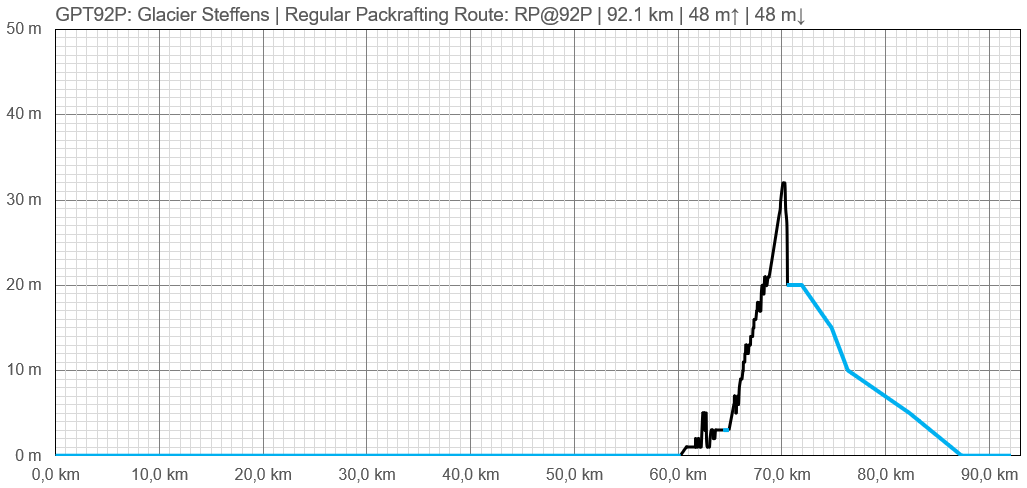GPT92P - Glacier Steffens
|
|
| |||||||||||||||||||||||||||||||||||||||||||||
Recent Alerts and Suggestions
Season Section Log
- GPT92P / Packrafting from Tortel to Glaciar Steffen and visit of Lago Santa Ana / Meylin Ubilla and Jan Dudeck / 4 days / December 4 to December 7
I drafted this fjord packrafting section several years ago without good knowledge of the typical wind pattern, the normal wind intensity and without reports from other packrafters. Satellite images were the primary source of information for planning this route. But we are now ground-truthing this section to collect more information of this fascinating and rarely visited area on the southern edge of the Northern Patagonian Icefield.
What we learned about the human history in this region:
Kawesqar people (sea nomads) may have travelled these fjords but the lack of sea life in this sweat water fjord may have made this particular fjord less attractive for these hunters and gatherers (the high influx of meltwater results in a very low salt concentration on the top layer of water therefore hardly any seashells and other sea life is visible).
The area was first invaded by larger numbers of humans about 100 years ago when lumberjacks from Chiloe cut virtually all Patagonian cypress (Fitzroya cupressoides) along these fjords. These very slowly growing trees were highly valued for their water resilient wood, that was exported in large quantities. Logging of Fitzroya continued until 1976 when it became forbidden by law because this tree species became nearly extinct. Now only already dead trees can be removed (although illegal logging still occasionally occurs). The steep mountains on either side of the fjords are now densely covered by other trees and many young cypress, therefore the scars caused by wood logging are invisible to the untrained eye and everything appears untouched by humans again.
In the last century a small number of settlers arrived with cattle, horses and sheep to intent lifestock farming in the very wet and remote valley of Rio Huemules that is clamped between the fjord Estero Steffen and the Northern Patagonian Icefield. This valley can only be reached by boat due to the surrounding mountains. A good number of these settlers have retreated but some remain in the area.
The route:
The first 30 km from Tortel to the river delta of Rio Huemules must either be packrafted or alternatively a motor boat can be chartered or twice per month a subsidized ferry can be taken.
From the coast a 10 km short trail leads up the wide open valley to Glaciar Steffen. Halfway Rio Huemules must be crossed by packraft.
About 25 years ago Glaciar Steffen retreated to a degree that a lake formed at the glacier end. Under NO circumstances camp on the nice pasture at the lake shore. Occasionally lakes higher up on the edge of glacier Steffen drain through the glacier resulting in substantial glacial lake outburst floods (GLOF). If this occurs, the lake level rises in one or two hours several meters. We camped next to National Park sign up on the glacier morane about 200 m from the lake shore.
The lake is full of stranded blocks of ice. After crossing this lake by packraft the upper part of the valley of Rio Huemules can be visited. In good weather a 1070 m high viewpoint can be ascended to admire the Northern Patagonian Icefield.
Optionally, Lago Santa Ana can visited which is located at the eastern end of Estero Steffen. This requires additionally 6 km fjord packrafting and walking up a 800 m short trail. There seams to be suitable beaches to camp at the end of this 8 km long lake.
Visiting this area without motorized transport requires:
- Resilience to enduring rain and temperatures between 5 and 15 degree C - A decked packraft, ideally a double/tandem - Patience to wait for low-wind windows (typically early in the morning or in the evening) - Machete to clean a spot for a tent
Wind and currents:
Traveling the fjord Estero Steffen northbound is a particular challenge for packrafters as the wind blows most of the time southbound. It took us a little under 10 hours to paddle the 30 km. On the first day we had to seek shelter after 3 hours of paddling when reaching Punta Lucia. The wind became simply too strong to advance. In the evening the wind calmed down somewhat and we covered another 4 km in 2 hours to get to a better camp site. On the second morning we covered the remaining distance against a constant but moderate wind from the north.
There are several suitable points to camp along the coast but a machete is often needed to clear a small spot for a tent.
Tidal currents were barely noticeable. There seams to be a weak outbound current especially where Rio Huemules drains into fjord but wind is clearly the dominant force.
Packrafting northbound in a decked double packraft (MRS Barracuda R2 Pro) was a clear advantage as the hull speed is noticeable higher than in a shorter single packraft. This allows to advance further in the often rather short calm periods. Also, the ratio between wind resistance and paddling propulsion is noticeable better in a double packraft then in single packraft.
Returning southbound in decked single packrafts is more convenient as packrafters will unlikely struggle against the wind but benefit from wind from the north.
There is decent mobile phone coverage in Tortel and in the lower valley of Rio Huemules to check weather and wind reports before departing into the fjord. We relied primarily on the weather App from www.nr.no and wind prediction App „Windy“.
Jose Vargas is the settler at waypoint Settler {92P} [37.2/1]. He is a very welcoming person who offered us to stay in an empty house next to his home. Since today’s weather report predicts 50 mm of rain we opting to stay a third night night at his place planning to return to Tortel by packraft tomorrow morning.
For season 2023/24 the GPT track files will be updated with the information gathered now.
More images and maps will be added later when we have hopefully better internet in Tortel. Packrafters that plan to visit GPT92P this season best contact us directly.
Summary Table
| GPT92P: Glacier Steffens | Hiking | Packrafting | |||||
| Group | P: Fiordos Sur | Total | - | - | 92.1 km | 24 h | |
| Region | Chile: Aysén (XI) | Trails (TL) | - | - | 7.2 km | 7.8% | |
| Start | Caleta Tortel | Minor Roads (MR) | - | - | - | - | |
| Finish | Caleta Tortel | Primary Roads (PR) | - | - | - | - | |
| Status | To be Verified & Recorded by GPS | Cross-Country (CC) | - | - | 2.5 km | 2.7% | |
| Traversable | (Maybe: Sep - May) | Bush-Bashing (BB) | - | - | - | - | |
| Packraft | Required | Ferry (FY) | - | - | - | - | |
| Connects to | GPT36P, GPT91P | Investigation (I) | - | - | - | - | |
| Options | 15 km (1 Options & Variants) | Exploration (EXP) | - | - | (92.1 km) | (100.0%) | |
| Hiking | Packrafting | Total on Water | 82.4 km | 89.5% | |||
| Attraction | - | 5 (of 5) | River (RI) | 20.5 km | 22.3% | ||
| Difficulty | - | 6 (of 5) | Lake (LK) | 1.4 km | 1.5% | ||
| Direction | None | Return | Fjord (FJ) | 60.6 km | 65.8% | ||
| Comment | Hiking: Hiking not feasible | ||||||
| Character | Valdivian Rain Forest, Sea Coast, Glaciers, Unpeopled Areas, River Packrafting, Lake Packrafting, Fjord Packrafting | ||||||
| Challenges | Bush Bashing, Demanding Navigation, Exploration Required | ||||||







